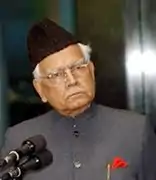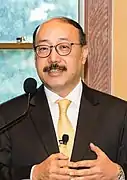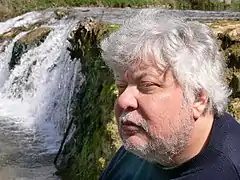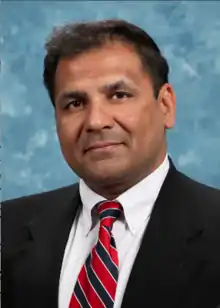Mayo College
Mayo College (informally Mayo) is a boys-only independent boarding school in Ajmer, Rajasthan, India. It was founded in 1875 by Richard Bourke, 6th Earl of Mayo, who was the Viceroy of India from 1869 to 1872. This makes it one of the oldest public boarding schools in India. The principal is Lt. Gen. (Retd) Surendra Kulkarni, who has occupied the post since January 2015 as the 17th principal.
| Mayo College | |
|---|---|
 Mayo College Coat of Arms | |
| Location | |
| Information | |
| School type | Public Boarding School |
| Motto | Let there be Light |
| Founded | 1875 |
| Founder | Richard Bourke, 6th Earl of Mayo |
| School board | CBSE |
| Authority | Board of Governors Mayo College General Council |
| President of General Council | H.H Maharaja Brijraj Singh of Kotah |
| Director | Lt Gen Surendra Hari Kulkarni (Retd) |
| Founder Headmaster | Col. Sir Oliver St. John |
| Faculty | 75 |
| Gender | Boys |
| Age | 9 to 18 |
| Number of pupils | 750 |
| Student to teacher ratio | 10:1 |
| Language | English |
| Campus | 350 Acres |
| Houses | 12 |
| Colour(s) | |
| Mascot | Peacock |
| Nickname | Mayo |
| Publication | Mayoor, Cyber Quest |
| Affiliation | Central Board of Secondary Education, New Delhi |
| Former pupils | Mayoites |
| Annual fees | ₹ 1,150,800 |
| Website | www.mayocollege.com |
The idea for the college was proposed in 1869 by Colonel Walter. It was founded in 1875 and Colonel Sir Oliver St John became its first principal.[1]
The founder's intention was to create an "Eton of India". The 1st Earl of Lytton, Viceroy of India, said in a speech on campus in 1879:
- The idea was well expressed long ago by Colonel Walter in an excellent and most suggestive report which may have influenced Lord Mayo when he founded the present college. In that very sensible report Colonel Walter pointed out that what was then most needed for the education of India's young rulers and nobles was an Indian Eton. Mayo is India's Eton and you are India's Eton boys.[2]
It aimed to provide the leaders of the princely states with an education similar to that given by Eton College. The British built Mayo for the sons of the Indian upper classes, particularly the princes and nobles of India.
The school houses 800 pupils aged between 9 and 18.
Coat of arms
The coat of arms was composed from the design furnished by Lockwood Kipling, a former principal of the School of Arts, Lahore, and father of Rudyard Kipling.
In the upper centre of the shield are Mayo Arms and Quarterings, a Lion Rampant and an open hand. On the right and left are the sun and the moon, typical of Suryavanshi and Chandravanshi, the two great families of Rajputs. Below are the Panch Rang, the five sacred colours of the Rajputs, Red, Gold, Blue, White and Green. In the centre is a Rajput fort – two towers connected by a curtain. The supports are on the right: a Bhil warrior with string bow and full quiver of arrows. On the left a Rajput, armed at all points, wearing a steel helmet with three plumes, a shield on his back, a dagger and katar in his belt, and a suit of chain covered with embroidered cloth and gauntlet on his hand.
The motto is "Let there be Light". The badge is a peacock, the sacred bird of Rajputana, standing on a two-edged, two-handed Rajput sword Khanda.
Postage stamp

On 12 April 1986, the Indian Postal Service released a stamp showing the main building of Mayo College. The multicolour stamp was designed by India Security Press. The first day cover shows the emblem of the college. The cancellation was designed by Nenu Bagga.[3]
School museum
Mayo College houses the Danmal Mathur Museum in Jhalawar House, which it shares with the Arts School. The museum showcases priceless antiques and an armoury section. It is considered to have one of the best collections of any school museum in the world.[4]
History and traditions

- Mayo's first student, H.H. Maharaja Mangal Singh of Alwar, arrived at the school gates in October 1875 on the back of an elephant accompanied by 300 retainers and a menagerie of tigers, camels and horses.
- One of the school's traditions is meeting for tea on the lawns known as Mughal Gardens immediately after the Annual Prizegiving ceremony. It is believed that M.N. Kapur (who went on to become one of Modern School New Delhi's most respected principals) did away with using a rope to divide English and Indian guests at this ceremony.
- The Annual Prizegiving, one of the oldest ceremonies at Mayo, has seen chief guests including Lord Irwin, Viceroy of India, Lord Chelmsford, governor general of India, Dr. Rajendra Prasad, ex-president of India, Sawai Man Singh II of Jaipur, Gayatri Devi of Jaipur, Vijayalakshmi Pandit, Zakir Hussain, ex-president of India, Karan Singh, Indira Gandhi, ex-prime minister of India, field marshal Sam Manekshaw, Sayyid Faher Bin Taimur of Oman, Birendra Shah, King of Nepal, Khushwant Singh, Madhavrao Scindia, Peter Ustinov, Jaswant Singh and LK Advani.
- Other traditions at Mayo include an annual horseback parade by the students and sporting fixtures between Old Boys and current students, including a polo match.
Mayo College General Council
There are more than 40 members of the Mayo College General Council including patron, life members, old boys' association representatives and MCGS old girls' representatives.
Council of monitors and sports captains

The school has a council of monitors consisting of students with posts dealing with school and house duties. There is a monitor and a prefect from each senior house. There are positions held by the students who excel in fields like academics, sports and co-curricular activities. Apart from the council of monitors, there are captains for each sport. Positions are held by the students of 12th class or, rarely, by juniors.
Houses
There are twelve houses of which eight are senior houses, a holding house (Class 7) and three junior houses.
The senior houses are Ajmer, Bharatpur ,Bikaner and Tonk, Colvin, Jaipur, Jodhpur, Kashmir and Rajasthan. The holding house is Oman. The junior houses are Ajaypal, Durgadas and Prithviraj.
Each senior and junior house can accommodate 60-75 students, apart from Oman (the holding house) which has a capacity of 120-130 students.
Sports
Mayo College has some of the best sporting facilities among the top boarding schools of India. There are facilities for students and staff consisting of playing fields for football and hockey and a cricket ground with a view of the Aravali Hills and an old red sandstone pavilion.
Horse riding was discontinued after Independence and revived again in 1994 with ten horses. Today, Mayo College has 60 horses and close to 250 boys and girls are trained. Mayo has ten polo players who practice regularly in the polo ground. Students are trained in equestrianism with a defined set of routines. Mayo College has participated in national level polo competitions and produced players like Himmat Singh Bedla, Nagender Singh, Pratap Singh, Sarveshwar Singh, Dhruv Singh and Shivdutt Singh. The school participated in the SUPA International Polo Tournament held in the UK in 2008. Mayo College also actively participates in the Jodhpur polo season and the Delhi Horse Show.
Squash players may choose between the modern glass-backed courts or the historic Fanshawe courts, open to the sky. Mayo College has a nine-hole golf course which was built recently. It also has many basketball courts.
There is a standard 400m running track. Athletics is one of the major seasonal and coaching sports. Every year, the entire school is trained in athletics as a seasonal game and then an inter-house competition is organized.
Tennis is one of the most popular sports in Mayo College. The Junior School and Senior School boys regularly play tennis in the evening as a daily routine throughout the year. There are around 17 tennis courts on the campus. There are five all-weather synthetic courts and four or five clay courts in the senior school. The junior school has four clay courts.
The gymnasium has a permanent instructor and trainer. It attracts approximately 40 boys every afternoon. It is equipped with modern stations, free weights, treadmills and stands.
Shooting has become a major sport here. The 10m shooting range is used by boys and girls (from Mayo Girls) of all classes and is one of the best ranges available at any school in India. The college owns imported rifles and pistols and has experienced coaches. Mayo has participated and won medals at national level tournaments.
Publications
Publications are supplied internally and sent to other public schools in India and abroad.
Mayoor
Mayoor was established in the late 1960s by the principal, Jack Gibson. It is a major bi-monthly newsletter with college news, updates and photos. The editorial team consists of an editor-in-chief who is an English teacher in the school and a team of editors from the student community. Mayoor used to have a Hindi section with articles and poems. This was removed when an independent Hindi newsletter called Paridrishya was established in 2006.
The Mayo Mail
The Mayo Mail is a weekly newsletter, established in 2008 by a group of students of Grade 7. It has become a publication which prints four fresh sheets every week and is called the "newspaper" of Mayo College. It consists of write-ups on school happenings and activities like the trademark Mayo "Tweets" and "Howlers".
Paridrishya
The independent Hindi magazine called Paridrishya was established in 2006. The magazine consists of articles, poems and jottings written by the school community. It has an editor-in-chief, who is a Hindi teacher in the school, and student editors.
Reflection
Reflection, established in 2007, is the student magazine. It is filled with poems, articles and facts that are illustrated with pictures. Reflection comes out three times a year.
College Magazine
The College Magazine is an annual collection of happenings that year in Mayo College. It has English and Hindi sections and contains reports, speeches, photographs, poems, articles and case studies of the school.
Other publications
- Cyber Quest is the IT magazine of Mayo College that contains technology-related articles and answers.
- Euphoria is an annual publication that reports on activities happening in the prize-giving function of the school.
- Zephyr – An Anthology of Poems is an annual publication that comes out in the prizegiving and contains the best poems written by the students.
Notable alumni
Alumni of Mayo College are known as Old Boys or Mayoites.
 Sir Hari Singh Bahadur, last ruler of Jammu and Kashmir
Sir Hari Singh Bahadur, last ruler of Jammu and Kashmir K. Natwar Singh (politician)
K. Natwar Singh (politician) Harsh Vardhan Shringla (Diplomat)
Harsh Vardhan Shringla (Diplomat) Indra Sinha (writer)
Indra Sinha (writer) Tinu Anand (film director)
Tinu Anand (film director) Amit Goyal (scientist and inventor)
Amit Goyal (scientist and inventor).jpg.webp) Vivek Oberoi (actor)
Vivek Oberoi (actor)
Students come to Mayo from overseas, including members of royal families from Oman and Nepal. The school has educated two sultans of Oman, one of whom is Said bin Taimur.
Mayo College has educated members of royal families including Bikaner, Alwar, Jammu and Kashmir, Kishangarh, Jaipur, Kangra, Udaipur, Jodhpur, Kutch, Kota and Dewas (Junior).
Sadashiv Rao II Puar of Dewas (Junior), Muhammad Mahabat Khan III of Junagadh, Yeshwant Rao Puar of Dewas (Junior), Sawai Man Singh II of Jaipur, Hari Singh of Jammu and Kashmir, Maharana Mahendra Singh Mewar, Arvind Singh Mewar of Mewar-Udaipur, Pragmulji III of Kutch, Prince Shivraj Singh of Jodhpur of Marwar-Jodhpur and Kirit Bikram Kishore Deb Barman, erstwhile Maharaja of Tripura from the second oldest continuing ruling lineage after the Mikados of Japan.
Alumni from Mayo have served in the armed forces and others serve as members of parliament and senior civil servants. Jaswant Singh is one of the few Indian politicians to have been the Minister for Defence, Finance and External Affairs; K. Natwar Singh of the Indian Foreign Service was India's Ambassador to Pakistan and as External Affairs Minister, Admiral Sunil Lanba is the former Navy Chief.
Lt. Gen. Nathu Singh Rathore, the second Indian officer to graduate from the Royal Military College, Sandhurst, was a distinguished strategist who served as a Division Commander in Burma during the Second World War. He was offered the position of Commander in Chief of the Indian Army in 1949 but declined the position in favour of his senior, K M Cariappa.[5]
Alumni have been Indian ambassadors to Morocco, Spain, Norway, Brazil, Libya, Switzerland and France.
The vice-chairman of Tata Motors, Ravi Kant, erstwhile chairman of Shell Oil-India, Vikram Singh Mehta, erstwhile chairman emeritus of Nestlé-India, Narendra Singh of Sarila, former chairman of Air India and Indian Airlines, Probir Sen, erstwhile chairman and MD of Axis Bank, P.J. Nayak, member of the Bank of England Monetary Policy Committee, Sushil Wadhwani, the retired chief general manager and executive director of the Reserve Bank of India and erstwhile managing director of NABARD, Yashwant Thorat, as well as Rakesh Mohan, who was deputy governor of the Reserve Bank of India all studied at Mayo. Mayo also has produced academic economists like Alok Bhargava who researches on food policy issues in developing and developed countries for formulating public policies. Mayo has produced scientists such as the eminent scientist in the field of electronic materials, Amit Goyal.
Tikaraj Aishwarya Katoch of Kangra, director of Indiabulls, donated the Kangra Amphitheatre in memory of his great-grandfather Maharaja Jai Chand Katoch who was one of the first few students of Mayo College.
Journalists who attended Mayo include Vir Sanghvi, Siddharth Varadarajan and Manvendra Singh. Writers include Vikram Chandra (Red Earth & Pouring Rain, Sacred Games) and Indra Sinha (Animal's People, shortlisted for the Man Booker Prize), Sudeep Chakravarti (Tin Fish and The Red Sun). Artists include Jaideep Mehrotra, Red Fashion designer Raghuvendra Rathore, celebrity chef Jiggs Kalra, the actors Rishi Kapoor, Ajay Mehta, Bobby Deol, Tinnu Anand, Vivek Oberoi, the filmmakers Pradip Krishen (also an environmentalist and writer of Trees of Delhi), Samir Karnik, Goldie Behl, Heeraz Marfatia and the theatre personality, Amir Raza Husain.
The school has produced sportsmen including Charu Sharma, cricketer Arun Lal and Lokendra S. Ghanerao (who captained India at polo).
Eknath Ghate, the acclaimed mathematician and winner of the Shanti Swarup Bhatnagar Prize for Science and Technology, is an alumnus of Mayo College.
Jai Pratap Singh, politician and cabinet minister in the Government of Uttar Pradesh.
J. T. M. Gibson Award for Excellence
The J. T. M. Gibson Award for Excellence was created in 2007 to be given to old boys who have, consistent with Jack Gibson's ideals, made a difference to society. Honorees include:
- 2007
- Ravi Kant, managing director Tata Motors (1961 batch)
- 2012
- Siddharth Varadarajan, editor, The Hindu newspaper
- Aamir Raza Husain, theatre personality
- 2013
- Shoumo Bhattacharya
- Leo Puri
- 2014
- Vijay Mohan Crishna
- Mohan Das Warrior
- 2015
- Rishad Faruqi
- Pradip Krishen
- 2016
- Sunil Lanba
- Karan Grover
- 2017
- Major Mohd Maroof Raza
- Harsh Vardhan Shringla
- 2018
- Yogen Dalal
- Manish Sabharwal[6]
See also
Notes
- List of Principals of Mayo College Archived 28 September 2007 at the Wayback Machine. Accessed 11 November 2007
- Mayo College as India's Eton Archived 28 July 2007 at the Wayback Machine A speech by the Earl of Lytton in 1879
- Detailed stamp release information
- Opportunities: The Mayo College, Ajmer, The Hindu, 9 June 2004
- "Bring back leaders like Lt.General Nathu Singh Rathore, Field Marshall Cariappa". Poonacha Machaiah. Archived from the original on 20 April 2016. Retrieved 10 April 2016.
- "JTM Gibson Award for Excellence". Remembering Jack Gibson. Retrieved 30 November 2019.